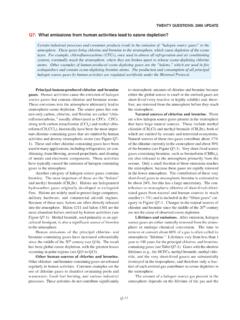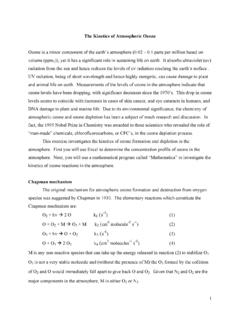Transcription of JOURNAL OF THE ATMOSPHERIC SCIENCES
1 VOL. 24, NO. 3 JOURNAL OF THE ATMOSPHERIC SCIENCES MAY 1967 Thermal Equilibrium of the Atmosphere with a Given Distribution of Relative Humidity SYUKURO MANABE AND RICHARD T. WETHERALD Geophysical Fluid Dynamics Laboratory, ESSA, Washington, D. C. (Manuscript received 2 November 1966) ABSTRACT Radiative convective equilibrium of the atmosphere with a given distribution of relative humidity is computed as the asymptotic state of an initial value problem. The results show that it takes almost twice as long to reach the state of radiative convective equilibrinm for the atmosphere with a given distribution of relative humidity than for the atmosphere with a given distribution of absolute humidity. Also, the surface equilibrium temperature of the former is almost twice as sensitive to change of various factors such as solar constant, CO2 content, 03 content, and cloudiness, than that of the latter, due to the adjustment of water vapor content to the temperature variation of the atmosphere.
2 According to our estimate, a doubling of the CO2 content in the atmosphere has the effect of raising the temperature of the atmosphere (whose relative humidity is fixed) by about 2C. Our model does not have the extreme sensitivity of ATMOSPHERIC temperature to changes of CO2 content which was adduced by Moller. 1. Introduction This study is a continuation of the previous study of the thermal equilibrium of the atmosphere with a convective adjustment which was published in the JOURNAL OF THE ATMOSPHERIC SCIENCES (Manabe and Strickler, 1964). Hereafter, we shall identify this study by In the vertical distribution of absolute humidity was given for the computation of equilibrium temperature, and its dependence upon ATMOSPHERIC temperature was not taken into consideration. How-ever, the absolute humidity in the actual atmosphere strongly depends upon temperature. Fig. 1 shows the distribution of relative humidity as a function of latitude and height for summer and winter. According to this figure, the zonal mean distributions of relative humidity of two seasons closely resemble one another, whereas those of absolute humidity do not.
3 These data suggest that, given sufficient time, the atmosphere tends to restore a certain climatological distribution of relative humidity responding to the change of temperature. If the moisture content of the atmosphere depends upon ATMOSPHERIC temperature, the effective height of the source of outgoing long-wave radiation also depends upon ATMOSPHERIC temperature. Given a vertical distribution of relative humidity, the warmer the ATMOSPHERIC temperature, the higher the effective source of outgoing radiation. Accordingly, the de-pendence of the outgoing long-wave radiation is less than that to be expected from the fourth-power law of Stefan-Boltzman. Therefore, the equilIbrium tempera-ture of the atmosphere with a fixed relative humidity depends more upon the solar constant or upon ab-sorbers such as CO2 and 03, than does that with a fixed absolute humidity, in order to satisfy the condi-tion of radiative convective equilibrium. In this study, we will repeat the computation of radiative convective equilibrium of the atmosphere, this time for an atmo-sphere with a given distribution of relative humidity instead of that for an atmosphere with a given distri-bution of absolute humidity as was carried out in As we stated in , and in the study by Manabe and Moller (1961), the primary objective of our study of radiative convective equilibrium is the incorporation of radiative transfer into the general circulation model SUMMER LATITUDE WINTER 4540, ,/ 40.
4 ---\ ~-35"'" ~/ ',_ \ _-u / ..', .. // 50 / .. --____ .. _--55 //60 .. / 60 __ -__ 65 // ~~--75-80----::..:.--__ D~~~~~~~~~~==~~~~ 90 80 70 60 50 40 LATITUDE 30 20 10 FIG. 1. Latitude-height distribution of relative humidity for both summer and winter (Telegadas and London, 1954). 241 242 JOURNAL OF THE ATMOSPHERIC SCIENCES VOLUME 24 of the atmosphere. Adopting the scheme of the com-putation of radiative transfer which was developed in , Manabe et al. (1965) successfully performed the numerical integration of the general circulation of the atmosphere involving the hydrologic cycle. In order to avoid a substantial increase in the number of degrees of freedom, the distribution of water vapor, which emerged as the result of the hydrologic cycle of the model atmosphere, was not used for the compu-tation of radiative transfer. Instead, the climatological distribution of absolute humidity was used. The next step is the numerical integration of the model with complete coupling between radiative transfer and the hydrologic cycle.
5 Before undertaking this project, it is desirable to answer the following questions by perform-ing a series of computations of radiative-convective equilibrium of the atmosphere with fixed relative humidity. 1) How long does it take to reach a state of thermal equilibrium when the atmosphere maintains a realistic distribution of relative humidity that is invariant with time? 2) What is the influence of various factors such as the solar constant, cloudiness, surface albedo, and the distributions of the various ATMOSPHERIC absorbers on the equilibrium temperature of the atmosphere with a realistic distribution of relative humidity? 3) What is the equilibrium temperature of the earth's surface corresponding to realistic values of these factors? There is no doubt that this information is indis-pensable for the successful integration of the funda-mental model of the general circulation mentioned above. Recently, Moller (1963) discussed the influence of the variation of CO2 content in the atmosphere on the magnitude of long-wave radiation at the earth's surface, COMPUTATION OF THE MIXING.
6 RATIO OF WATER VAPOR, r T: r= .622 h eS(T)/( (T 1 I CONVECTIVE ADJUSTMENT I t TT+I = I TT +(bTr)~ I bt R L).tCD and on the equilibrium temperature of the earth's surface. Assuming that the absolute humidity is inde-pendent of the ATMOSPHERIC temperature, he obtained an order-of-magnitude dependence of equilibrium temperature upon CO2 content similar to those obtained by Plass (1956), Kondratiev and Niilisk (1960), and Kaplan (1960). However, he obtained an extremely large dependence for a certain range of temperature when he assumed that relative humidity (instead of absolute humidity) of the atmosphere was given. One shortcoming of this study is that the conclusion was drawn from the computation of the heat balance of earth's surface instead of that of the atmosphere as a whole. Therefore, it seems to be highly desirable to re-evaluate this theory, using as a basis the computation of radiative convective equilibrium of the atmosphere with a fixed relative humidity. The results are presented in this study.)
7 2. Radiative convective equilibrium a. Description of the model. As we explained in the previous paper and in the introduction, the radiative convective equilibrium of the atmosphere with a given distribution of relative humidity should satisfy the following requirements: 1) At the top of the atmosphere, the net incoming solar radiation should be equal to the net outgoing long-wave radiation. 2) No temperature discontinuity should exist. 3) Free and forced convection, and mixing by the large-scale eddies, prevent the lapse rate from exceeding a critical lapse rate equal to km-l. 4) Whenever the lapse rate is subcritical, the condi-tion of local radiative equilibrium is satisfied. 5) The heat capacity of the earth's surface is zero. 6) The atmosphere maintains the given vertical dis-tribution of relative humidity (new requirement). COMPUTATION OF MEAN EMISSIVITY AND ABSORPTIVITY COMPUTATION OF TEMPERATURE CHANGE DUE TO RADIATION (bTlf bt R FIG. 2. Flow chart for the numerical time integration.
8 MAY 1967 SYUKURO MANABE AND RICHARD T. WETHERALD 243 In the actual computation, the state of radiative convective equilibrium is computed as an asymptotic state of an initial value problem. Details of the pro-cedure are described in Appendix 1. The flow chart of the marching computation is shown in Fig. 2. In this figure e.(T) denotes the saturation vapor pressure of water vapor as a function of temperature T, and h denotes the relative humidity. T denotes the number of the time steps of numerical integration, and I is the indexing of the finite differences in the vertical direction. (Refer to Appendix 3 for the illustration of levels adopted for vertical differencing.) The exact definitions of mean emissivity and mean absorptivity are also given in , pp. 365-366. Since the changes of absolute humidity correspond to the change of air temperature, the equivalent heat capacity of moist air with relative humidity h may be defined as [La ( (T )] Cp'=Cp 1+- -, Cp aT p-he.(T) (1) where Land Cp are the latent heat of evaporation and the specific heat of air under constant pressure, respec-tively.)
9 The second term in the bracket appears due to the change of latent energy of the air. The reader should refer to for the following information. 1) Computation of the flux of long-wave radiation. 2) Computation of the depletion of solar radiation. 3) Determination of mean absorptivity and emissi-tivity. Some additional explanation of how we determine the absorptivity is given in Appendix 2. b. Standard distribution of ATMOSPHERIC absorbers. In this subsection, the vertical distributions of water vapor, carbon dioxide, ozone , and cloud, which are used for the computations of thermal equilibrium, and those of heat balance in the following section, are described. They are adopted unless we specify otherwise. The typical vertical distribution of relative humidity can be approximated with the help of the data in Fig. 3. In this figure, the hemispheric mean of relative humidity obtained by Telegadas and London (1954) and that of relative humidity obtained by Murgatroyd (1960) are shown in the upper and lower troposphere, re~pectively.
10 The stratospheric distributions of relative humidity obtained by Mastenbrook (1963) at Minne-apolis and Washington, D. C., are also plotted after some smoothing of data. Referring to this figure, the following linear function is chosen to represent the vertical distribution of relative humidity, , ( ) h=h* , (2) CD ~ .. o 100 200 300 400 gs 500 ~ a: Q. 600 700 800 900 1000 (TELEGADAS 8 LONDONl .00 .10 .20 .30 .40 .50 .60 .70 .80 .90 RELATIVE HUMIDITY FIG. 3. Vertical distribution of relative humidity (Mastenbrook, 1963; Murgatroyd, 1960; Telegadas and London, 1954). where h* is the relative humidity at the earth's surface, equal to , Q= pi P*, and p* is surface pressure. When Q is smaller than , Eq. (2) gives negative value of h. Therefore, it is necessary to specify the humidity distribution for small Q values. According to the measurements by Mastenbrook (1963) and Houghton (1963), the stratosphere is very dry and its mixing ratio is approximately 3Xl0-6 gm gm-1of air.)






